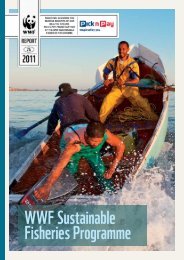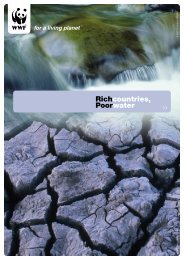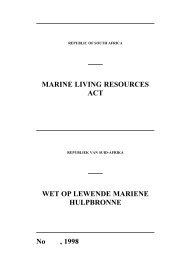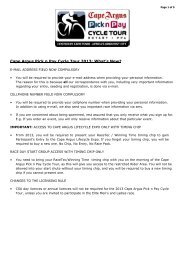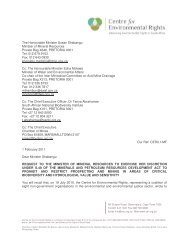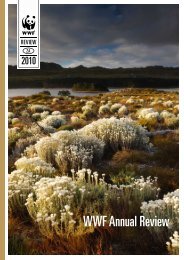State of Management of South Africaââ¬â¢s ... - WWF South Africa
State of Management of South Africaââ¬â¢s ... - WWF South Africa
State of Management of South Africaââ¬â¢s ... - WWF South Africa
- No tags were found...
Create successful ePaper yourself
Turn your PDF publications into a flip-book with our unique Google optimized e-Paper software.
STATE OF MANAGEMENT OF SOUTH AFRICA’S MARINE PROTECTED AREAS1.2.3 The evolution <strong>of</strong> MPA <strong>Management</strong>The first MPA in <strong>South</strong> <strong>Africa</strong> was established in 1964 in Tsitsikamma. In 1977 agovernment-established task group developed a policy on MPAs that set out criteria for MPAmanagement (Lemm & Attwood 2003) and declared that the management <strong>of</strong> a MPA shouldbe assigned to one competent authority (Attwood et al. 2000). Hockey and Buxton completeda review on the <strong>State</strong> <strong>of</strong> MPAs 1989 and found that: The legislation relevant to MPAs was too diverse and in need <strong>of</strong> consolidation.A decentralised system whereby Provincial authorities have the ability to designateMPAs would be more effective.The awareness and enforcement at MPAs was not sufficient.From 1990 onwards <strong>South</strong> <strong>Africa</strong> declared many MPAs (Bewana 2009). By 1996 there werea listed total <strong>of</strong> 112 marine and coastal protected areas, and, in response to conflict overresources, ambiguous goals and requests for additional protected areas, a Marine ReservesTask Group was established (Attwood et al. 1997). This task group was commissioned toreview the administration, management, design and representativity <strong>of</strong> MPAs and to preparea policy for MPAs in <strong>South</strong> <strong>Africa</strong> (Attwood et al. 1997). The review, which involved aquestionnaire survey, identified the following weaknesses in management: The absence <strong>of</strong> a national MPA coordinating body.Inadequate legislation (Sea Fisheries Act) – which could not control non-fishingrelated activities in MPAs.MPAs mainly focused on preservation <strong>of</strong> ecosystems and enhancement <strong>of</strong> fisheries,at the expense <strong>of</strong> multiple-use <strong>of</strong> MPAs.Lack <strong>of</strong> management plans.Objectives for MPAs not documented or publicised.Lack <strong>of</strong> participatory process that involve consultation <strong>of</strong> users and adjacentcommunities.Insufficient numbers <strong>of</strong> dedicated enforcement staff.Inadequate monitoring programmes.The lack <strong>of</strong> public awareness.The shortage <strong>of</strong> funds.The Marine Living Resources Act No 18. <strong>of</strong> 1998 was created to replace the previouslegislation pertaining to MPAs and fisheries. In 2000, 19 MPAs were declared under this Act.In 2003, an assessment <strong>of</strong> the state <strong>of</strong> management <strong>of</strong> MPAs was conducted by Lemm andAttwood. This was more exhaustive than the previous reviews as it involved site visits andinterviews with those most involved in MPA management (Lemm & Attwood 2003). Theassessment indicated that there had been considerable improvement, notably through newnational legislation that governs both fisheries and MPAs and the assignment <strong>of</strong> a nationalcoordinating body (Marine and Coastal <strong>Management</strong>). However it was reported that most <strong>of</strong>the weaknesses found in the previous assessment still needed substantial improvement.Pg 10






